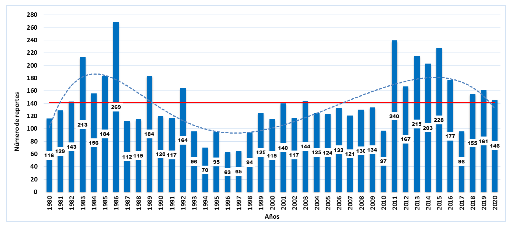Characterization of the reports of severe local storms in Cuba between 1980-2020
Main Article Content
Abstract
Severe local storms are meteorological events that present one or several severe phenomena such as: tornadoes, hail, strong linear winds and waterspouts. These meteorological phenomena are a reality in Cuba every year, causing damage to the economy and society, therefore it is necessary to characterize the Severe Local Storms in the national territory from the records of reports in the period 1980-2020. In the research, the General Weather Statements, prepared daily by the Forecast Center of the Institute of Meteorology, were reviewed, as well as the Meteorological Notes prepared by the Provincial Meteorological Centers, from which a table of reports was created, with a high degree of reliability. For the study, the distribution of reports by years and months, severity events, province, as well as the combined occurrence of events was analyzed. The results show that Severe Local Storms occur every year in Cuba, with a higher incidence between May and July, which coincides with the rainy period of the year. On the other hand, it was found that the most predominant events are hail and windstorms.
Downloads
Article Details

This work is licensed under a Creative Commons Attribution-NonCommercial 4.0 International License.
Those authors who have publications with this journal accept the following terms of the License Attribution-NonCommercial 4.0 International (CC BY-NC 4.0):
You are free to:
- Share — copy and redistribute the material in any medium or format
- Adapt — remix, transform, and build upon the material
The licensor cannot revoke these freedoms as long as you follow the license terms.
Under the following terms:
- Attribution — You must give appropriate credit, provide a link to the license, and indicate if changes were made. You may do so in any reasonable manner, but not in any way that suggests the licensor endorses you or your use.
- NonCommercial — You may not use the material for commercial purposes.
- No additional restrictions — You may not apply legal terms or technological measures that legally restrict others from doing anything the license permits.
The journal is not responsible for the opinions and concepts expressed in the works, they are the sole responsibility of the authors. The Editor, with the assistance of the Editorial Committee, reserves the right to suggest or request advisable or necessary modifications. They are accepted to publish original scientific papers, research results of interest that have not been published or sent to another journal for the same purpose.
The mention of trademarks of equipment, instruments or specific materials is for identification purposes, and there is no promotional commitment in relation to them, neither by the authors nor by the publisher.
References
Alfonso, A. P. (1986). Aspectos climatológicos de las turbonadas en la Ciudad de la Habana. Ciencias de la Tierra y el Espacio, 12, 85-100.
Alfonso, A. P. (1994). Climatología de las tormentas locales severas de Cuba: Cronología. Editorial Academia.
Álvarez, L., & Borrajero, I. (2018). Distribución espacial de fenómenos meteorológicos en Cuba clasificados a partir del tiempo presente I. Revista Cubana de Meteorología, 24(1), 95-110. http://rcm.i nsmet.cu/index.php /rcm/article/view/262/302.
Alvarez, L., Borrajero, I., Alvarez, R., Aenlle, L., Rivero, I. R., Iraola, C., Rojas, Y., & Hernández, H. (2012). Estudio de la marcha interanual de la frecuencia de ocurrencia de observaciones con tormenta para el territorio cubano. Revista de Climatología, 12. http://webs.ono.com/reclim/reclim12a.pdf
Carnesoltas, Mario. (2002). La circulación local de brisa de mar y tierra. Conceptos fundamentales. Revista cubana de Meteorología, 9(1).
Fujita, T. T. (1978). Manual of downburst identification for project NIMROD (Satellite and Mesometeorology Research Paper NTIS PB-286048; p. 104). Dept. of Geophysical Sciences, University of Chicago.
Golden, J.H. (1973). Some statistical aspects of waterspout formation. Weatherwise, 26(3), 108-117.
Lecha, L. B., Lapinel, B., & Paz, L. R. (1994). El Clima de Cuba. Academia.
Orlanski, I. (1975). A rational subdivision of scales for atmospheric processes. Bulletin of the American Meteorological Society, 65(1), 527-530.
Peterson, R. E. (1978). Waterspout statistics for Nassau, Bahamas. Journal of Applied Meteorology and Climatology, 17(4), 444-448.
Rivero, R., Pérez, C., & Antuña, J. C. (1981). Climatología sinóptica de las tormentas severas locales de Cuba. Boletín Científico Técnico, 6(1), 1-9.
Varela, A. (2017). Formación de tornados no asociados a superceldas en la región occidental de Cuba [Tesis de Maestría]. Instituto Superior de Tecnologías y Ciencias Aplicadas, Universidad de La Habana.

